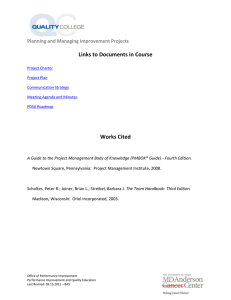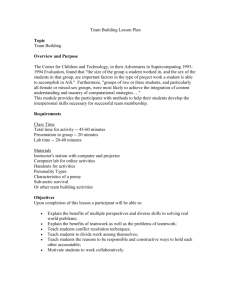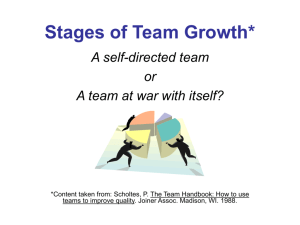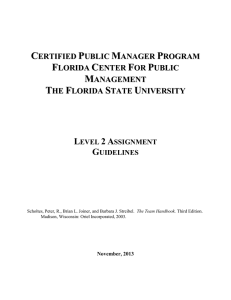Spring 2004, Vol. 3 No. 1 Loretta Ferguson Cochran, Ph.D.
advertisement
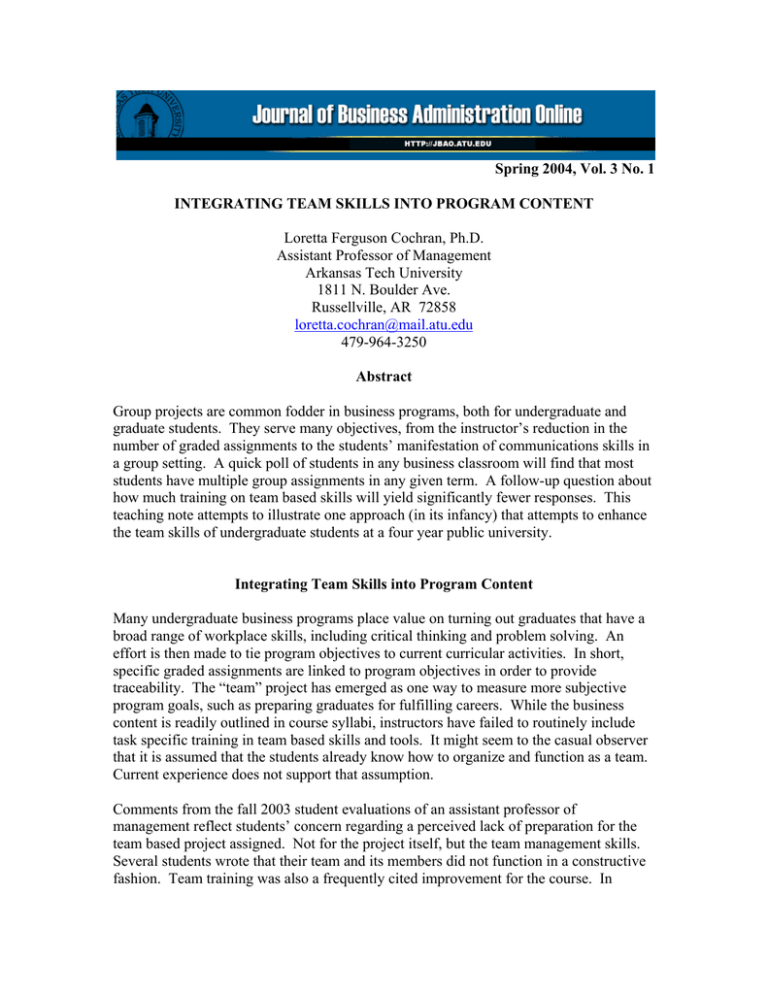
Spring 2004, Vol. 3 No. 1 INTEGRATING TEAM SKILLS INTO PROGRAM CONTENT Loretta Ferguson Cochran, Ph.D. Assistant Professor of Management Arkansas Tech University 1811 N. Boulder Ave. Russellville, AR 72858 loretta.cochran@mail.atu.edu 479-964-3250 Abstract Group projects are common fodder in business programs, both for undergraduate and graduate students. They serve many objectives, from the instructor’s reduction in the number of graded assignments to the students’ manifestation of communications skills in a group setting. A quick poll of students in any business classroom will find that most students have multiple group assignments in any given term. A follow-up question about how much training on team based skills will yield significantly fewer responses. This teaching note attempts to illustrate one approach (in its infancy) that attempts to enhance the team skills of undergraduate students at a four year public university. Integrating Team Skills into Program Content Many undergraduate business programs place value on turning out graduates that have a broad range of workplace skills, including critical thinking and problem solving. An effort is then made to tie program objectives to current curricular activities. In short, specific graded assignments are linked to program objectives in order to provide traceability. The “team” project has emerged as one way to measure more subjective program goals, such as preparing graduates for fulfilling careers. While the business content is readily outlined in course syllabi, instructors have failed to routinely include task specific training in team based skills and tools. It might seem to the casual observer that it is assumed that the students already know how to organize and function as a team. Current experience does not support that assumption. Comments from the fall 2003 student evaluations of an assistant professor of management reflect students’ concern regarding a perceived lack of preparation for the team based project assigned. Not for the project itself, but the team management skills. Several students wrote that their team and its members did not function in a constructive fashion. Team training was also a frequently cited improvement for the course. In response to these direct indicators and the instructor’s own observation, three changes were made in the course syllabi for the management and organizational behavior (MOB) course and the operations management (OM) course as offered in the next term. First, students were asked to complete an information card at the beginning of the semester indicating their best out-of-class team meeting time and whether they had a preferred team mate. Every effort was made by the instructor to place students with similar schedules in teams as well as with preferred team mates. Field experience in team based organizations indicates that selecting team members that match the needs of the team are one indicator of success (Wellins, Byham, and Wilson, 1991). An additional factor in constructing the groups was student’s major. Each group had at least one accounting or economics major to work with three or four management/marketing majors. This provided a breadth of represented skills. Other majors, such as information science, were also equitability distributed. The ability to self select at least one group member was designed to improve team member relations. Group cohesiveness was a targeted objective of this selection strategy. Second, team skill training was added to the course schedule for both courses. It appeared in the course outline after the last day to drop the course without penalty. The training lasted approximately 90 minutes. It was at this time that team assignments were made and groups met for the first time. The topics covered in this training are included in the Table 1. Table 1 Topics Covered in Team Training Characteristics of a Dynamic Team Definition of Team Members’ Roles and Responsibilities Patterns of Positive Contributions Positive Team Member Behaviors Positive Team Member Contributions Six Steps to Conflict Resolution Supportive Action Matrix Symptoms of Poor Teamwork Team Ground Rules Tips for Good Communication Source Scholtes, Joiner, and Streibel, 1998 Scholtes, Joiner, and Streibel, 1998 Scholtes, Joiner, and Streibel, 1998 Scholtes, Joiner, and Streibel, 1998 Scholtes, Joiner, and Streibel, 1998 Scholtes, Joiner, and Streibel, 1998 Montgomery, 1995 Scholtes, Joiner, and Streibel, 1998 Scholtes, Joiner, and Streibel, 1998 Scholtes, Joiner, and Streibel, 1998 A lack of team training is a common theme in reasons given by firms for team failure (Wellins, Byham, and Wilson, 1991). Indeed, consider the impact of giving students an assignment for which they had not had the prerequisite courses. In one sense, assigning group work without any regard to the skill level of the participants is a similar misstep. This training focused on team outcomes, member behaviors, and member skills. Team outcomes, such as characteristics of team behavior and symptoms of poorly functioning teams, gave the students some positive and negative results to anticipate. This gave them some idea of what a “good” team should look like along with indicators of poor group performance. Member behaviors training included instruction on individual actions that were a positive influence to the team’s overall performance. Some of the tools provided to team members included a review of the conflict resolution process and critical success factors for effective communication. Lastly, during training, teams were required to select a team leader and a facilitator. Roles and responsibilities for these two positions were taken from industry examples (Scholtes, Joiner, and Streibel, 1998, Montgomery, 1995). The primary distinction was that the leader monitored team effectiveness while the facilitator managed the meeting process. The purpose of the facilitator was to complete the activity matrix at the conclusion of each meeting and help the team meet assignment deadlines. Team leaders were to provide the teams with direction and focus, making sure that each member was participating, and encouragement to provide input into the project. Feedback at this point appears promising. Antidotal evidence suggests that the students responded positively to the training sessions and the initial formation of teams. Students report feeling connected to their team members and satisfied with the overall project experience. An analysis of self and team member evaluations will provide commentary on how to improve the training for the next term. References Montgomery, W. L. (1995). Power-Up Teams & Tools. Pittstown, NJ: The Montgomery Group. nd Scholtes, P. R., Joiner, B. L., and Streibel, B. J. (1998). The Team Handbook. 2 edition. Madison, WI: Straus Printing Company. Wellins, R. S., Byham, W. C., and Wilson, J. M. (1991). Empowered Teams. San Francisco: Jossey-Bass.
